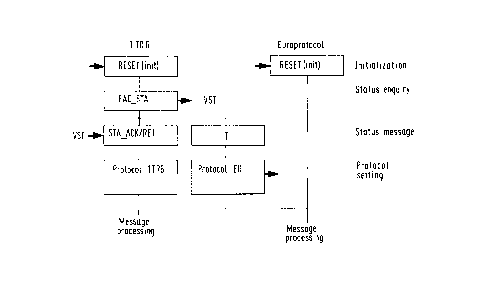Some of the information on this Web page has been provided by external sources. The Government of Canada is not responsible for the accuracy, reliability or currency of the information supplied by external sources. Users wishing to rely upon this information should consult directly with the source of the information. Content provided by external sources is not subject to official languages, privacy and accessibility requirements.
Any discrepancies in the text and image of the Claims and Abstract are due to differing posting times. Text of the Claims and Abstract are posted:
| (12) Patent: | (11) CA 2062621 |
|---|---|
| (54) English Title: | PROTOCOL ADAPTATION |
| (54) French Title: | ADAPTATION DE PROTOCOLE |
| Status: | Expired and beyond the Period of Reversal |
| (51) International Patent Classification (IPC): |
|
|---|---|
| (72) Inventors : |
|
| (73) Owners : |
|
| (71) Applicants : |
|
| (74) Agent: | SMART & BIGGAR LP |
| (74) Associate agent: | |
| (45) Issued: | 1998-05-19 |
| (22) Filed Date: | 1992-03-10 |
| (41) Open to Public Inspection: | 1992-09-12 |
| Examination requested: | 1994-11-22 |
| Availability of licence: | N/A |
| Dedicated to the Public: | N/A |
| (25) Language of filing: | English |
| Patent Cooperation Treaty (PCT): | No |
|---|
| (30) Application Priority Data: | ||||||
|---|---|---|---|---|---|---|
|
If a new protocol is introduced in all exchanges (VST),
e.g., the ETSI protocol T/S 46-30 in Europe, the old
protocol (e.g., 1TR6 in Germany) is to be replaced by the
ETSI protocol in all terminals without the need for
an on-site hardware/software adaptation.
To accomplish this, the terminal is provided in advance
with two protocols (1TR6, ETSI-T/S 46-30) (stored in
EEPROMs, for example), and by means of an unambiguous
status inquiry at the time of conversion in the exchange,
the latter is interrogated for the current protocol. The
terminal is then operated in accordance with a status
message indicating the protocol being used by the exchange.
Si un nouveau protocole est adopté dans tous les centraux (VST), p. ex. le protocole ETSI T/S 46-30 en Europe, il faudra remplacer l'ancien protocole (p. ex. 1TR6 en Allemagne) par le protocole ETSI dans tous les terminaux sans avoir à effectuer d'adaptation matérielle/logicielle sur place. cette fin, le terminal est adapté à l'avance à deux protocoles (1TR6, ETSI-T/S 46-30) (stockés dans des EEPROM, p. ex.), et lors de la conversion du central, le protocole en usage est demandé au central au moyen d'une interrogation d'état non ambiguë. Le terminal est ensuite exploité conformément à un message d'état indiquant le protocole utilisé par le central.
Note: Claims are shown in the official language in which they were submitted.
Note: Descriptions are shown in the official language in which they were submitted.

2024-08-01:As part of the Next Generation Patents (NGP) transition, the Canadian Patents Database (CPD) now contains a more detailed Event History, which replicates the Event Log of our new back-office solution.
Please note that "Inactive:" events refers to events no longer in use in our new back-office solution.
For a clearer understanding of the status of the application/patent presented on this page, the site Disclaimer , as well as the definitions for Patent , Event History , Maintenance Fee and Payment History should be consulted.
| Description | Date |
|---|---|
| Inactive: IPC expired | 2022-01-01 |
| Inactive: IPC from MCD | 2006-03-11 |
| Time Limit for Reversal Expired | 2003-03-10 |
| Letter Sent | 2002-03-11 |
| Grant by Issuance | 1998-05-19 |
| Inactive: Final fee received | 1998-01-29 |
| Pre-grant | 1998-01-29 |
| Notice of Allowance is Issued | 1997-11-14 |
| Notice of Allowance is Issued | 1997-11-14 |
| Letter Sent | 1997-11-14 |
| Inactive: Status info is complete as of Log entry date | 1997-11-07 |
| Inactive: Application prosecuted on TS as of Log entry date | 1997-11-07 |
| Inactive: IPC removed | 1997-11-04 |
| Inactive: First IPC assigned | 1997-11-04 |
| Inactive: IPC assigned | 1997-11-04 |
| Inactive: IPC assigned | 1997-11-04 |
| Inactive: Approved for allowance (AFA) | 1997-11-03 |
| Request for Examination Requirements Determined Compliant | 1994-11-22 |
| All Requirements for Examination Determined Compliant | 1994-11-22 |
| Application Published (Open to Public Inspection) | 1992-09-12 |
There is no abandonment history.
The last payment was received on 1998-02-23
Note : If the full payment has not been received on or before the date indicated, a further fee may be required which may be one of the following
Please refer to the CIPO Patent Fees web page to see all current fee amounts.
| Fee Type | Anniversary Year | Due Date | Paid Date |
|---|---|---|---|
| Final fee - standard | 1998-01-29 | ||
| MF (application, 6th anniv.) - standard | 06 | 1998-03-10 | 1998-02-23 |
| MF (patent, 7th anniv.) - standard | 1999-03-10 | 1999-02-17 | |
| MF (patent, 8th anniv.) - standard | 2000-03-10 | 2000-02-11 | |
| MF (patent, 9th anniv.) - standard | 2001-03-12 | 2001-02-16 |
Note: Records showing the ownership history in alphabetical order.
| Current Owners on Record |
|---|
| ALCATEL N.V. |
| Past Owners on Record |
|---|
| RUDOLF HOYLER |
| WOLFGANG ARNOLD |